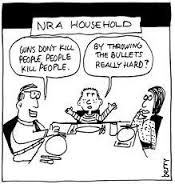For the last twenty years the gun lobby has been promoting more concealed-carry and more gun ownership in general by spreading the idea that guns protect us from crime. This pitch is even more pronounced as they go after new consumer markets like women and African-Americans, populations that have traditionally resisted gun ownership but are also considered to be more vulnerable to criminal attacks for reasons of gender or where they happen to live.
This whole notion about guns being used to thwart crime first took off in an article published by the criminologist Gary Kleck in 1995. Kleck previously published Point Blank, a book presented as a balanced corrective to the gun debate because “each side simplifies, caricatures, and sometimes willfully distorts the arguments of the other, setting up and knocking down their respective straw men with ease.” But his article on defensive gun use departed from this balanced point of view, totally dismissing the modest estimates of defensive gun use (DGU) of most previous scholarship and advancing a much higher number based on a telephone survey conducted by his own marketing firm.
 Just as Kleck’s findings on DGUs were seized upon by the pro-gun lobby as “proof” that gun ownership was a positive response to crime, so he was attacked by gun control advocates who felt that his argument was overwhelmingly biased towards helping the spread of CCW, as well as the sale of more guns. It should be noted that the NRA, in the aftermath of Brady and the assault weapons ban, began softening its long-time reliance on sporting uses of guns and turned instead to actors like Charlton Heston whose TV ads for the gun lobby called the streets of DC “the most dangerous place in the world,” particularly if an unarmed person walked them at night.
Just as Kleck’s findings on DGUs were seized upon by the pro-gun lobby as “proof” that gun ownership was a positive response to crime, so he was attacked by gun control advocates who felt that his argument was overwhelmingly biased towards helping the spread of CCW, as well as the sale of more guns. It should be noted that the NRA, in the aftermath of Brady and the assault weapons ban, began softening its long-time reliance on sporting uses of guns and turned instead to actors like Charlton Heston whose TV ads for the gun lobby called the streets of DC “the most dangerous place in the world,” particularly if an unarmed person walked them at night.
At the same time Kleck published his findings on DGUs, he also published research that, in the main, contradicts everything he claimed to be beneficial about DGUs. I am referring to a report he submitted to the Institute of Justice in 1994 on self-protection and rape which, curiously, was never cited in his DGU article that was published the following year. In this report he did the one thing that I felt largely discounted his claims to the social utility of carrying a gun by comparing the results of resistance to rapes by victims who didn’t us a gun but resorted to other resistance behaviors, such as physically resisting without a gun, yelling, trying to get a third party’s attention or resisting with a weapon other than a gun.
Guess what? It turns out that Kleck’s own research demonstrates that rape and assault victims who used methods other than guns to resist an attack not only were as successful in their efforts as they were when they used guns, but in some types of resistance actually sustained fewer injuries than when they defended themselves with guns. To quote Kleck: “Self-protective actions that appear to significantly reduce the risk of injury and serious injury include ‘attacking without weapon,’ ‘threatening p. without weapon,’ run away/hide,’ and ‘called the police.'” Of the 733 rape victims covered in this study, almost half who engaged in some form of self-protective behavior thwarted the actual rape.
It should be added, incidentally, that the data for this study was drawn from the National Crime Victimization Survey (NCVS), a source that Kleck considered totally unreliable in buttressing his claims about the validity of his research on DGUs. But of course the real problem with Kleck’s study of defensive gun use is that his DGU survey didn’t deal with crime victims at all. The respondents were asked whether having a gun on their person thwarted what otherwise might have been a criminal attack; a question which requires a gigantic leap of faith to even assume that the answers could be used to say anything about whether guns can protect us from crime. And Kleck, who started off trying to figure out what we know about guns, ends up just telling some of us what we want to believe, whether we really know it to be true or not.
Leave a Reply